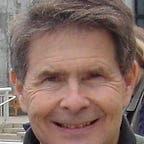Alan Perlis: The First Computer Scientist
In 1960 I was enjoying a beer and watching TV at my Carnegie Tech fraternity when one of the brothers said, “The professor in my class said that anyone who was in the rat-race for grades could simply write it on the front of their exam paper, and he’d award it to him.” I said, “That sounds like a fascinating subject, what is it?” The subject was computer programming, and the professor was Alan Perlis.
I enrolled in his programming class and found myself in a large lecture hall with hundreds of geeky students. In the front of the room was a strange-looking man without hair, or even eyebrows — Perlis. He was expounding on some software trick; but what it was for, I couldn’t imagine. His idea of lecturing seemed to be to talk about whatever was amusing or perplexing him that day.
Programming homework involved creating programs by punching holes in paper cards, submitting them in a drawer, and waiting many hours for the output printed on oversized sheets of paper. Frequently, my program was rejected because of a niggling syntax error. I would sometimes see Perlis himself racing around in the glass-enclosed computer room, stuffing our cards into the computer. Perlis assigned whimsical homework problems like “Design a language for describing motel layouts,” apparently because he had recently stayed in a motel. I thought all this was pretty stupid compared to understanding the physics of the universe, but everyone seemed to think this was fun.
Perlis ran the university’s math department and computer center. In most universities computers were a precious resource, often sequestered like scientific instruments, in departments that could afford them. Perlis, a graduate of Tech, aimed every computer he could get at the students. His message was, “Come on in, the water’s fine,” He was like the Pied Piper, gathering all manner of students to this new subject. He was enthusiastic and irreverent, compared with the professors of other subjects. He had random, swashbuckling ideas. He seemed to be saying, “Here is an open field that is going to grow, so do whatever you like. It will probably be useful. You don’t have to be a genius; just go for it.”
Perlis was active on international committees that defined new programming languages. He was the president of the computing’s first academic association, and the first winner of the Turing award, which became computing’s equivalent of the Nobel Prize. I began to think, “If this doofus is a big cheese, there can’t be much competition, especially compared to physics, which had people like Einstein. It looks like a good career choice.”
When I was a computer science graduate student at MIT, Perlis came to give a talk. He talked about his programming language, which allowed formula manipulation, like differentiation, along with numerical computation. At one point he bragged that the system could apply L’Hopital’s rule, a calculus trick. The audience started to buzz, and someone asked how often it had to be used. Without missing a beat, Perlis said “Once!” and plunged on with his presentation, which ended abruptly as he rushed out to catch a plane. I believe Perlis often tried to say the most unexpected thing he could think of.
As I pursued my academic career elsewhere, Carnegie Tech became Carnegie Mellon; and computer science prospered. There were several important people, but all management fell to Perlis who added the head of the new computer science department to his other jobs. He was the ultimate laissez faire administrator. He held no meetings or discussions and did not attempt to control things. He simply made seat-of-the-pants decisions as they arose. His motto seemed to be, “Ready, fire, fire, fire.”
- He attracted faculty from around the world, ignoring academic credentials and emphasizing energy.
- Graduate students invited him to parties and he always came, often with his wife Sydell.
- At an early stage of the department some students complained about the way the graduate curriculum was organized. They mounted what amounted to a palace revolt. Perlis met them and said, “Okay, show me an alternative.” They did, and he adopted it.
- He ran things employing the reasonable person principle, which said, “We can’t have rules to cover every situation, so people should do what they think is reasonable; and we’ll worry about consequences as they unfold.” If you Google “Reasonable Person Principle” the first five answers attribute it to Carnegie Mellon, even though it was a 19th-century legal term.
- In my search for a faculty job, I wrote to the department but never received a reply. Then, a few months after I’d started teaching at Berkeley, he called me saying, “The low salaries Berkeley pays are terrible! How would you like to come to CMU?” When I said “not now” he said, “OK, let’s pretend this phone call never happened,” and hung up.
- He wrote papers about computing, but he was most famous for hundreds of epigrams that make sense to programmers. Some samples:
- In software, everything is possible, but nothing is easy.
- One man’s constant and is another man’s variable.
- To iterate is human, to recurse, divine.
Later, I worked at Xerox’s Palo Alto Research Center. Perlis, by this time a professor at Yale and using a wheelchair, was a visiting consultant. All the Carnegie Mellon alumni there revered him and entertained him with dinner parties to the point that I wondered if he ever ate alone.
One day, in a hallway discussion with my colleagues, I delivered an impromptu speech on Perlis’s unique contribution to our field:
He realized, earlier than most, that programming was where the action was. Most of the computer science pioneers were just combining computers with their knowledge一digital engineering, mathematics, psychology, etc. But Perlis had the vision of software as a new, world-transforming technology. He once remarked to an academic conference, “You’re talking like mountaineers studying how to climb Mount Everest most efficiently, when the real problem is how to transport thousands of people a day to the top of hundreds of mountains.” His solution to that problem was the development of programming languages, an idea that became the focus of computer science for decades and helped software become a trillion-dollar industry.
To my surprise my speech was interrupted by Perlis’s voice coming out of a nearby office that he was visiting: “Do I hear my name being mentioned?” We never discussed this afterwards, but I’m happy it happened the way that it did.
The last time I saw Perlis before he died I visited him to talk about the new computing system we were building at Carnegie Mellon. We had a quiet, relaxed dinner, just Alan, Sydell and I.
At the 25th anniversary of the department he started, I gave a laudatory speech about him at a banquet attended by his wife and children. Then I organized a fund-raising drive to create an endowed chair named after him.
For the next twenty years, I took on many administrative jobs at the university, sometimes heading multiple organizations and trying to be as innovative as Perlis. It was an impossible act to follow but was a way to honor him for the wonderful career he had lured me into.







